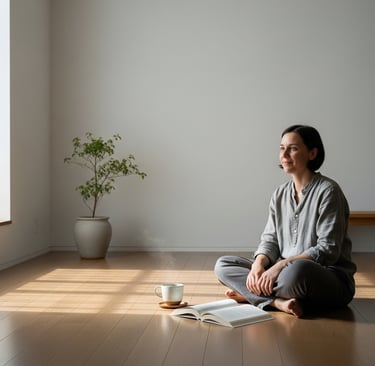Stoicism and Minimalism: Living a Life of Purpose and Simplicity
In a culture of constant consumerism, endless notifications, and societal pressure to accumulate, the ancient philosophy of Stoicism and the modern movement of minimalism converge to offer a powerful antidote. Both paths teach that happiness and resilience stem not from possessions, but from clarity, focus, and intentional living.
STOICISM
7/29/20252 min read


1. The Stoic Minimalist Mindset
Material Possessions Are Indifferent:
Stoics hold that external goods—wealth, status, belongings—are neither inherently good nor bad; only our attitude and use of them matter. Minimalism echoes this, urging us to detach from excess and appreciate what we truly value.
Internal Focus:
While minimalism clears your physical space, Stoicism declutters your mental space. Stoic practice helps you resist cravings, distractions, and reactive habits that clutter the mind, so your focus stays on what you can control.
Purpose Over Possessions:
By minimizing attachment to things, you direct your time and attention toward what endures: personal growth, community, meaningful work, and the cultivation of virtue.
2. Practical Steps to Live Simply and Wisely
Conduct a “Need Test”:
Before any new purchase or commitment, ask: “Does this align with my highest values? Is it truly necessary?” Say no to what doesn't measure up.
Daily Reflection Ritual:
Each evening, journal three points:
One thing you controlled well
One thing you let go of
One lesson learned
This mirrors Marcus Aurelius’s approach of regular self-examination.
Declutter in Micro-Tasks:
Apply the 90/20 rule: If you haven’t used an item in 90 days, decide what to do with it in 20 minutes or less.
Practice Voluntary Discomfort:
Periodically abstain from comforts (skipping take-out, unplugging from streaming, taking cold showers). These small hardships build resilience and gratitude for what you do have.
Align Spending with Virtue:
Automate a portion of your funds toward meaningful priorities—experiences, helping others, personal development.
Mindful Consumption:
Limit digital notifications, set up “tech-free” blocks, and intentionally choose when to engage online.
3. Modern Examples of Stoic Minimalism
Work & Productivity:
Professionals seeing the benefits of a clear workspace and Stoic “pre-meeting meditations” make better decisions and experience less anxiety.
Family Life:
Parents who simplify their children’s toys and schedules find that kids develop deeper gratitude and creativity—echoing Stoic teachings on the sufficiency of nature.
Creativity:
Artists and writers who pare down to just the tools they truly need experience less overwhelm and more originality.
4. Cultivating a Life of Simplicity and Purpose
Minimalism and Stoicism, practiced together, help you anchor life in what matters most—virtue, service, simplicity, and deep contentment. By letting go of excess (possessions, obligations, digital noise) and focusing on what you can control, you not only regain time and energy but also build inner strength and clarity.
Embrace this synergy:
Simplify your outer world
Master your inner world
Live each day with purpose, courage, and joy in the essentials
A life of purpose and simplicity is not about deprivation, but about making space—physically and mentally—for what truly fulfills you.
Waste no more time arguing about what a good man should be. Be one - Marcus Aurelius
We suffer more often in imagination than in reality - Seneca
Wealth consists not in having great possessions, but in having few wants - Epictetus
